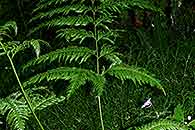Pteris dentata Forssk.
Synonyms |
Pteris arguta Aiton |
|---|---|
Common name |
|
Description |
Rhizome erect to procumbent, up to 10 mm in diameter; rhizome scales linear-lanceolate in outline, dark brown to blackish chestnut, shiny, up to 5 mm long. Fronds tufted, arching, herbaceous, up to 2.1 m high. Stipe up to 1.2 m long, strawcoloured, darker and with few scattered scales towards the base, glabrous. Lamina up to 1 × 0.8 m, deltoid to ovate in outline, usually 2- to 3-pinnatifid but variable, basal pinnae basiscopically developed. Pinnae narrowly oblong in outline, 5-24 x 1.5-7.5 cm; ultimate lobes linear to oblong-triangular, apices toothed, base unequally united to the costa, margins toothed except for the fertile lobes which have entire margins along the sori; veins free, no veins anastomosing below the sinus; glabrous on both surfaces, spines present at the vein junctions on the uppersurface only. Rhachis strawcoloured, glabrous, smooth. Sori linear, continuous, marginal; indusia entire, membranous. |
Notes | Can be distinguished from Pteris buchananii which has a widely creeping rhizome and anastomosing veins below the sinus; Pteris catoptera and Pteris friesii have ultimate lobes with entire apex margins. |
Derivation | dentata: toothed, referring to the serrate margins of the ultimate lobes of the lamina. |
Habitat | Grassland, upland bamboo forest, montane rain forest, often by stream sides, also old rubber plantations, bare slopes of landslips and on trunks of oil palms. |
Distribution worldwide | Africa and Arabia, Fernando Po, Ascension I., St. Helena, Cape Verde Is., Mascarene Is. and Madagascar |
Distribution in Africa |
Angola, Burundi, Cameroon, Dem. Republic of Congo, Equatorial Guinea (incl. Bioko), Ethiopia, Ghana, Kenya, Malawi, Morocco and Western Sahara, Mozambique, Namibia, Rwanda, South Africa, Sudan and South Sudan, Swaziland, Tanzania , Uganda, Zambia, Zimbabwe. |
Growth form |
Terrestrial. |
Literature |
|


